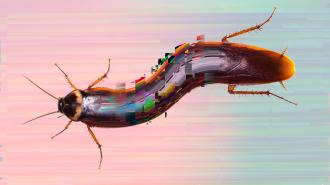A new CRISPR technique has gene-edited cockroaches for the first time, and its creators believe it will work on more than a million other insect species, too.
If they’re right, it could be used to control (or eliminate) pests — and answer fundamental questions in biology.
The challenge: To create gene-edited insects, researchers typically inject CRISPR or another tech directly into the animals’ laid eggs at an early stage of development.
“These problems have plagued researchers who wish to perform genome editing on a wide variety of insect species.”
Takaaki Daimon
This requires specialized, expensive equipment and highly skilled lab workers. Each insect species needs its own specialized setup, and some can’t be edited at all — cockroaches, for example, encase their eggs in a hard shell that’s difficult to pierce.
“These problems with conventional methods have plagued researchers who wish to perform genome editing on a wide variety of insect species,” said senior study author Takaaki Daimon of Kyoto University.
Gene-edited insects: Scientists from Kyoto University and Spain’s Institute of Evolutionary Biology have developed “direct parental CRISPR” (DIPA-CRISPR), a new technique for creating gene-edited insects.
Instead of targeting eggs, their CRISPR system is injected into the bodies of adult female insects near where their embryos are developing. In their study, the system was tested to produce insects with white eyes by preventing the expression of certain genes.
“This method should work for more than 90% of insect species.”
Takaaki Daimon
In cockroaches, up to 22% of the offspring inherited the desired trait. In red flour beetles, more than 50% did. The mutations were also passed down to the offspring of the gene-edited insects.
“In a sense, insect researchers have been freed from the annoyance of egg injections,” said Daimon. “We can now edit insect genomes more freely and at will. In principle, this method should work for more than 90% of insect species.”
The caveats: The researchers note that the way some species, such as fruit flies, reproduce would prevent the technique from being effective in them. A scientist would also need to have a solid understanding of ovary development in their target species to use DIPA-CRISPR on it.
“[T]his can be challenging in some species, given the diverse life histories and reproductive strategies in insects,” the researchers write in their study.
“We may be … opening up a future in which we can fully utilize the amazing biological functions of insects.”
Takaaki Daimon
Additionally, while DIPA-CRISPR could effectively deactivate specific genes (“knock-out”), it wasn’t as successful at adding genes (“knock-in”) — knock-in experiments with the red flour beetle had an efficacy of just 1.2%.
The fact that DIPA-CRISPR worked at all in the knock-in experiments suggests that its efficacy could potentially be improved in the future, though.
Why it matters: DIPA-CRISPR is far simpler than the standard method for creating gene-edited insects. It requires minimal equipment and works with commercially available Cas9 proteins — that gives it an advantage over ReMOT Control, a similar CRISPR tech used to edit insects and arachnids.
“By improving the DIPA-CRISPR method and making it even more efficient and versatile, we may be … opening up a future in which we can fully utilize the amazing biological functions of insects,” said Daimon.
“In principle, it may be also possible that other arthropods could be genome edited using a similar approach,” he added. “These include agricultural and medical pests such as mites and ticks, and important fishery resources such as shrimp and crabs.”
We’d love to hear from you! If you have a comment about this article or if you have a tip for a future Freethink story, please email us at tips@freethink.com.
